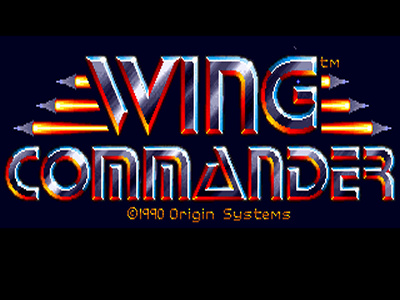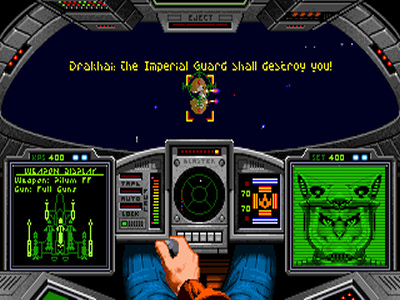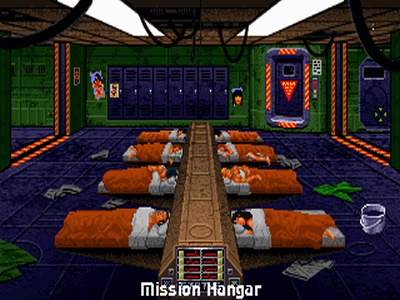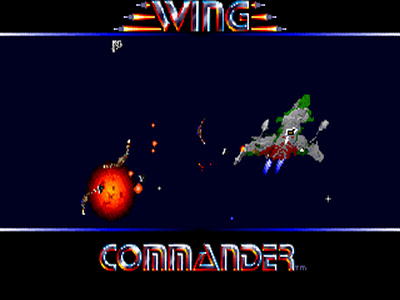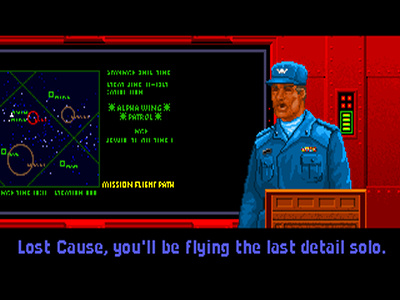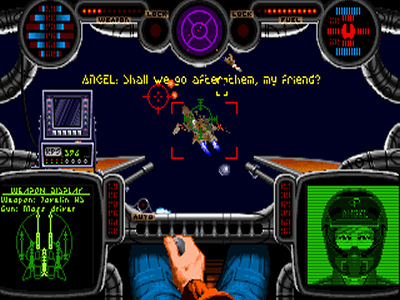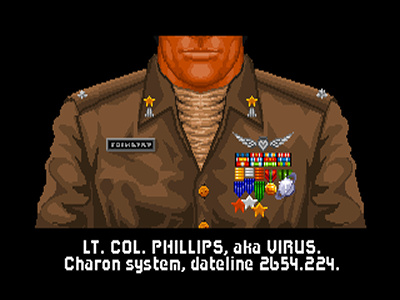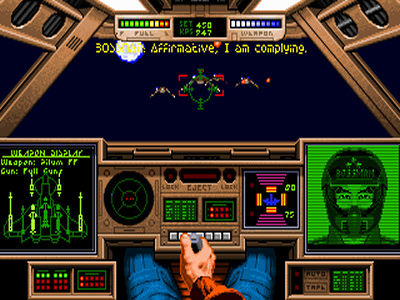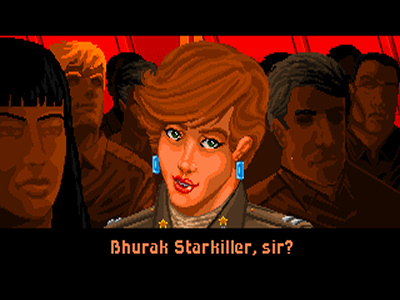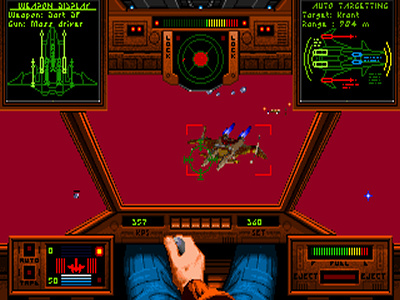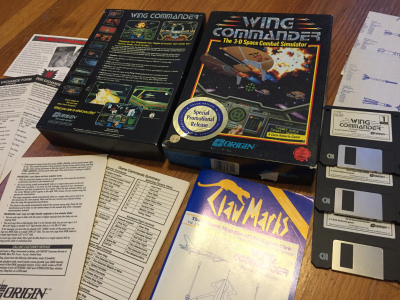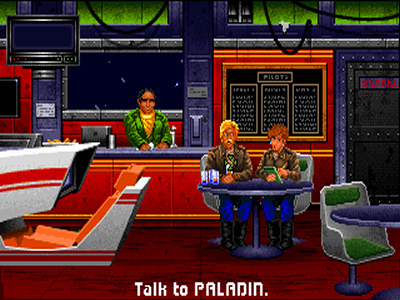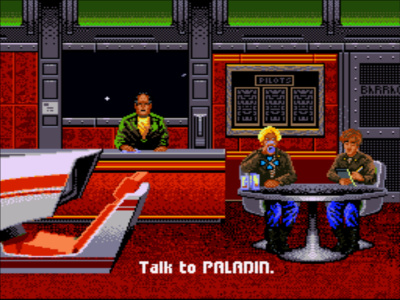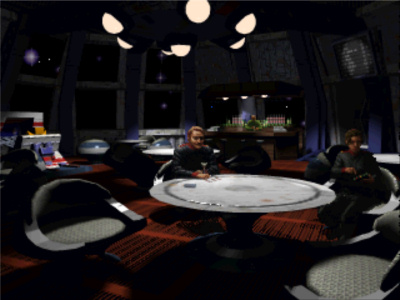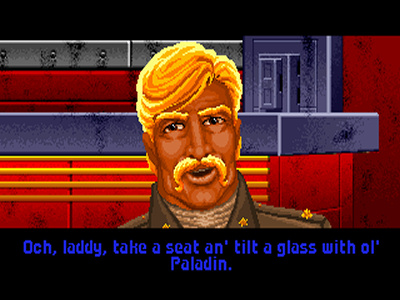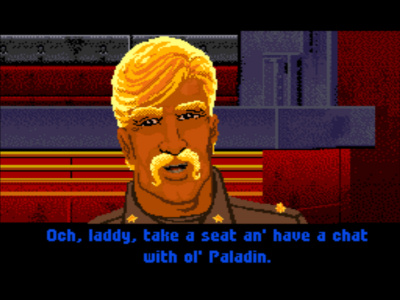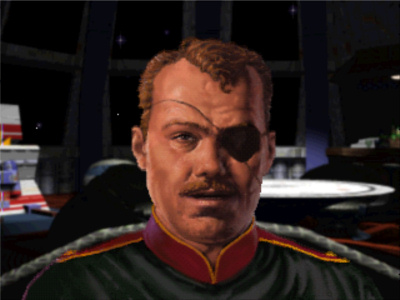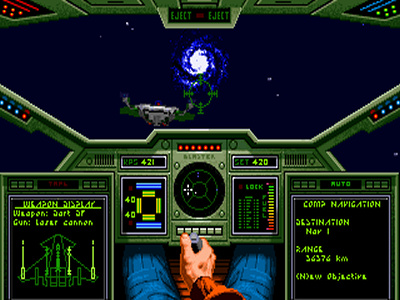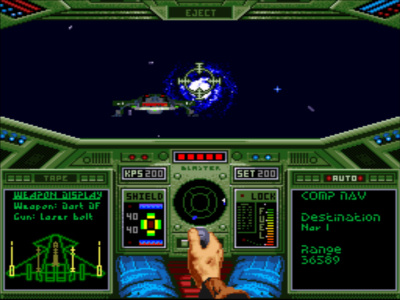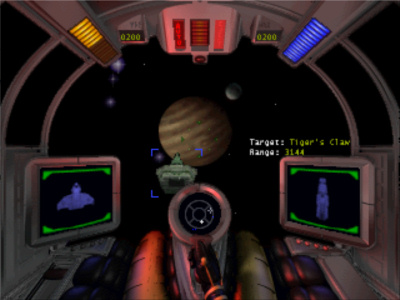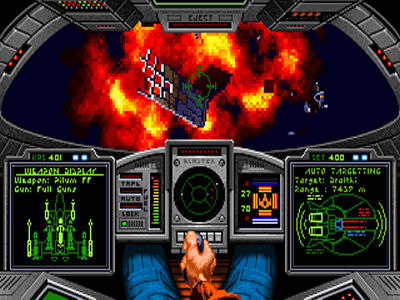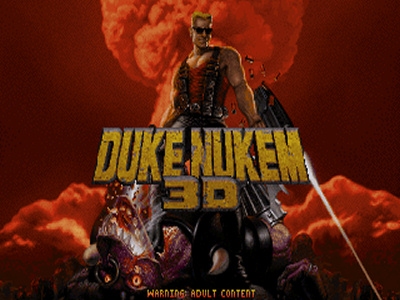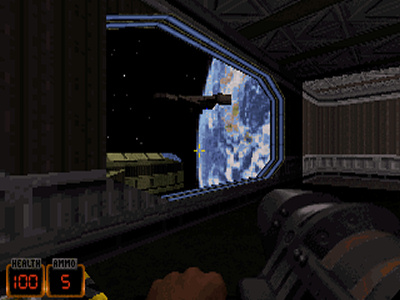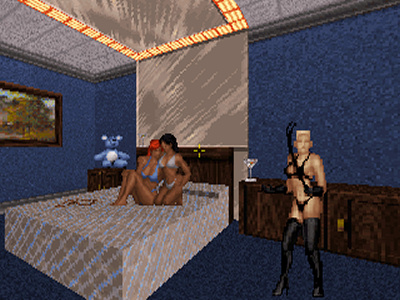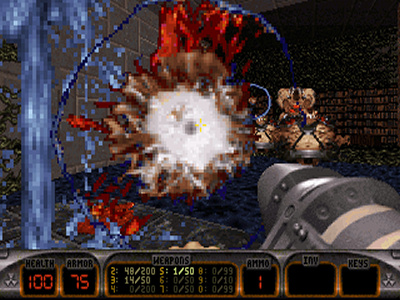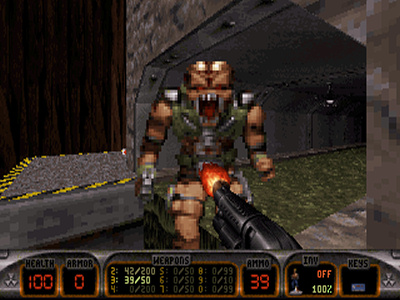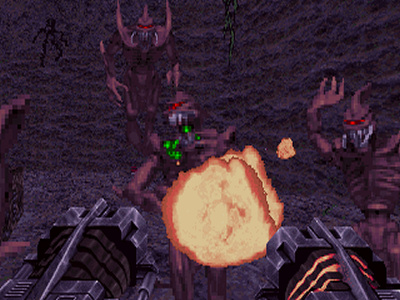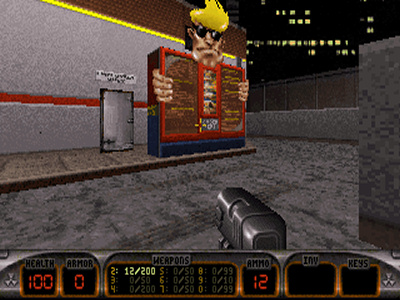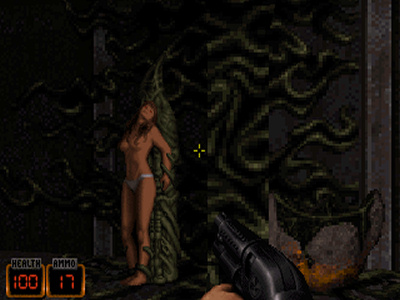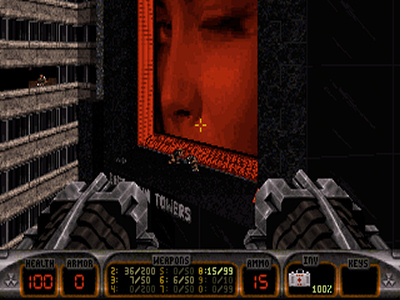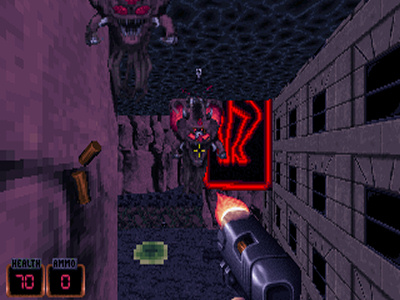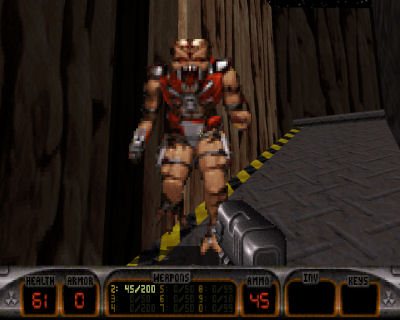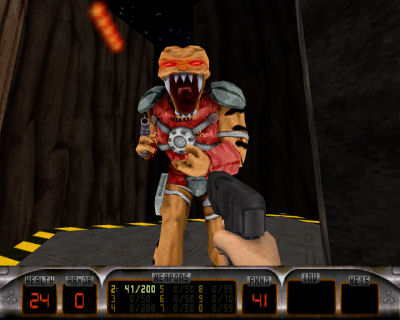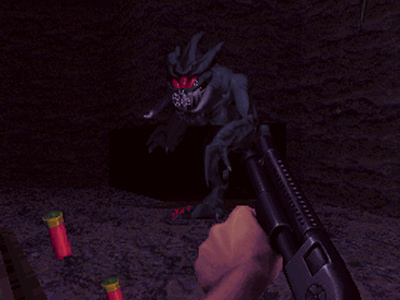Note: The screenshots posted on this page have been scaled up a little from their tiny native resolutions as well as had their aspect ratios corrected to proper 4:3 dimensions as they should have looked on CRT monitors originally. For posterity’s sake you can also click them to view the “pixel perfect” originals, which I especially encourage for the screenshots of the SCI version, as my conversion process made its dithering shading technique look all kinds of shitty.
Introduction
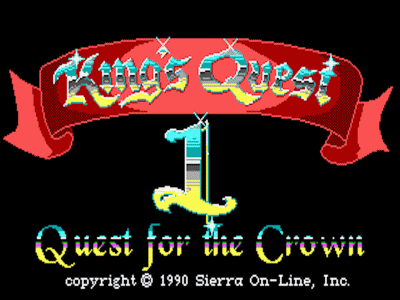
“King’s Quest!”
Representing Sierra’s place in my retro reviews section has been long overdue, and I’ve decided to start close to the very beginning with the legendary King’s Quest. Probably the biggest single milestone in the birth of the “graphical adventure” genre as well as the game that truly started Sierra’s meteoric climb to the top of the industry.
Sierra On-line (then simply On-line Systems) got started when founders Ken and Roberta Williams coupled the text based input parser of earlier interactive fiction games with graphical renderings of scenes, trading written descriptions for crude, still images and decidedly less verbose text. Still, this “Hi-Res Adventure” series of adventure games was considered to be quite innovative at the time and turned some heads, including IBM’s, who offered Sierra a contract to develop a game for their upcoming PCjr system. With an actual budget behind them, Sierra developed the next evolution of their graphical adventure game concept by actually animating these screens, showing the player character’s real time movements and actions from a third person perspective, and thus in 1984 the King’s Quest series and the AGI engine that powered most of Sierra’s early landmark adventure games were born. If Sierra invented the genre with it’s first Hi-Res Adventure, Mystery House, it set the new standard for it for much of the rest of the decade with King’s Quest.
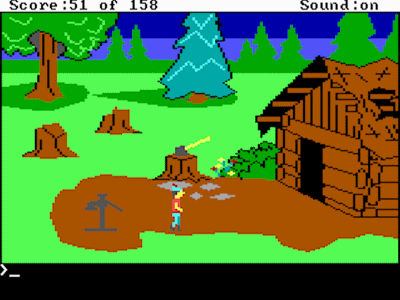
“The original AGI King’s Quest in all its glory.”
I honestly couldn’t tell you when or where I was first exposed to the series, only that looking back, the name “King’s Quest” seemed ubiquitous within the personal computer gaming space, and certainly its style of blocky graphics and text parser input was one of the first things my young mind went to when I thought of gaming experiences I couldn’t experience on my consoles and longed for on a computer. Aside from a couple of brief sessions with the original AGI Police Quest at a friend’s house when I was a kid, it wasn’t until getting my first IBM compatible PC in the early 90s that I finally dove headlong into my first Sierra graphical adventure game. Actually, it was Space Quest, not King’s Quest, that I latched onto, and I’m still a devout Roger Wilco fan to this day. Despite being a fan of the fantasy genre, King’s Quest, to me, always seemed like Sierra’s stuffiest, most serious adventure series. Don’t get me wrong, I always wanted to get into King’s Quest, and I remember almost rescuing the budget CD-ROM release of King’s Quest V from the bargain bin countless times, but with my non-existent, teenage funds it just never happened.
Indeed, it wasn’t until the release of Adventure Game Studio in the late 90s, and a team of skilled AGS developers calling themselves, at the time, Tierra Entertainment, released a VGA remake of King’s Quest in 2001, that I actually played the game for the first time. For shame!
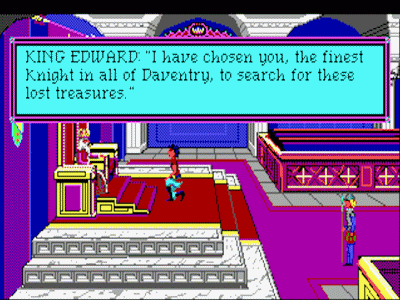
“…and so the quest begins.”
King’s Quest, like so many old PC games, was ported to all manner of different personal computers and saw a variety of releases and remakes over the years. With this review I’ll mainly be focusing on the 1987 AGI release of King’s Quest, by then renamed King’s Quest: Quest for the Crown, which was essentially just an update of the original 1984 version with a newer build of the AGI engine. I also played and will talk a lot about the 1990 remake of the game, which was done with the AGI engine’s successor, the SCI engine. The 2001 AGS remake I mentioned was based on this SCI version and therefore doesn’t require too much attention of its own, but since many people who decide to play King’s Quest for the first time in 2017 will likely play that version I’ll definitely bring it up as well.
Gameplay
King’s Quest is typical of practically all of the graphical adventure games that came after it: The player guides their character from scene to scene exploring the world, occasionally collecting items. Sometimes the character’s path into a certain area is blocked, an item is unreachable, or perhaps an enemy needs to be defeated. In any case, overcoming these challenges presents the player with a puzzle that needs to be solved. The vast majority of these puzzles involve using previously collected items with the environment. Points are awarded for certain actions, usually collecting valuable items and successfully solving puzzles. I’ll talk a lot more about the actual mechanical aspects of these actions under the Controls section.
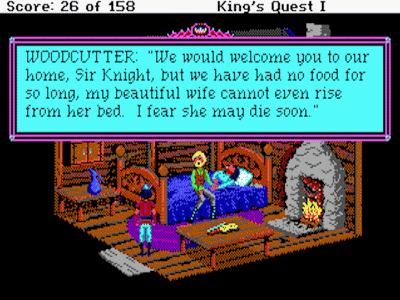
“Great. The only subjects of my future kingdom that I actually meet, and they’re dying.”
Unsurprisingly for such an old game, the puzzles are relatively simple. Interestingly though, there are optional items and multiple solutions to most puzzles. One big benefit of having multiple solutions is that the designers can have their bizarre, “moon logic” solutions alongside their more intuitive ones. Of course, it’s the more creative solutions that award the most points or, often enough, don’t requiring giving up an item to complete and losing you the points you received when you picked that item up originally in the process. I appreciate having the option of not bashing my head against my desk in frustration to finish the game, in any case, and indeed at the end of my first time playing through for this review I had completed the game almost entirely with the more straightforward but low point solutions. Constantly tracking and displaying your point total can really encourage a bit more experimentation or at least variety in subsequent playthroughs though, which I like.
One important aspect that differentiates King’s Quest from most later graphical adventure games: Rather than following any sort of highly structured, linear narrative, King’s Quest presents an almost entirely open world right from the start. Outside of a small number of items needing to be obtained and puzzles solved in a certain order, there are no restrictions on where you can go or what you can do. Fans of a more scripted experience might dislike this aspect of it but I find it to be liberating here.
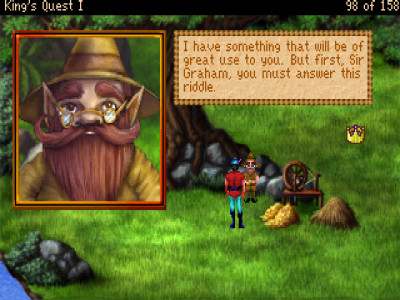
“If you don’t hate this little bastard you’ve probably not played King’s Quest.”
There are negatives too, though. First of all, it’s generally very useful to have knowledge of the various classic fairy tales that Roberta Williams obviously drew heavily from. If you don’t know about the Three Billy Goats Gruff, Jack and the Beanstalk, and Rumpelstiltskin, for example, you might not have a clue how to proceed during certain segments of the game. Second, some of those moon logic solutions are well and truly out there, almost to the point of being Easter eggs. The Rumpelstiltskin puzzle is infamous for this. Finally, let’s just say that the well known and often despised Sierra adventure game practice of brutally murdering the player character at every turn, usually without any warning, and with a frequency that makes the game seem almost mean spirited, apparently started nice and early. My advice is to save frequently and try to laugh at the absurdity of watching your character die in ridiculous ways.
Still, to the game’s credit I actually never got legitimately stuck on a puzzle. There were times I was positive that there were other solutions than the ones I had figured out. For example, I knew I had to be able to dispatch the dragon without throwing my dagger at him, losing it in the process, but the item I needed to do so, and indeed the process I needed to obtain it, simply weren’t nearly as obvious as the dagger solution. Likewise, it was far more logical to me to use the slingshot to dispatch the giant than the other, more peaceful solutions. Look, I know violence isn’t always the answer, but in King’s Quest it certainly holds true that it’s often the easiest solution.
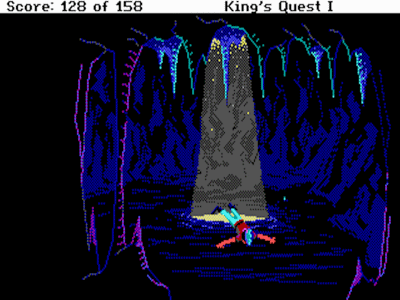
“A grand entrance. As an aside, I love the weird color palette of the caves in the SCI version…”
Difficult, perhaps insane puzzles are one thing, but “dead man walking” scenarios are another altogether. These are situations in which if you miss an item or fail to do an action early on, which is easy to do, you won’t be able to solve a puzzle or get out of an area much later in the game. Missing the mushroom before entering the Land of the Leprechauns, for example, will have you solve your way through a few different puzzles and acquire a couple of new, point worthy items before you realize that you’re completely stuck and need to load a saved game from before you entered the area. Don’t have an appropriate save file? I hope you like restarting from the beginning. Not cool.
Personally, I played in a totally methodical way: mapping each screen, searching for any and all potentially hidden items, and checking into if not outright solving any puzzles as I came across them. Using this strategy I only ended up missing one of the non-gated items, and I didn’t end up absolutely needing it to proceed. Again, most of my initial solutions to puzzles weren’t the high point options, but I beat the game relatively easily with few hints.
Story
In the original 1984 PCjr release when you walk into the castle and talk to the King Edward you learn that he’s dying and that his kingdom, Daventry, is crumbling. He tasks you, Sir Graham, his finest knight, with seeking out three magical treasures that can help restore the kingdom to greatness. That’s pretty much the story. The manual itself sets up a better written version of the same exceedingly simple premise, but that’s about it.
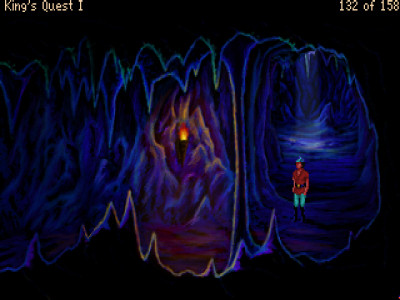
“…Expertly updated in AGDI’s remake!”
The 1987 release sets up the exact same scenario in the game, but the manual completely revises the story, setting up a more detailed and darker account of what happened to King Edward and the Kingdom of Daventry that’s more akin to the fairy tales it borrows so heavily from. Instead of just randomly going out and finding these fabled magical treasures, it turns out that the artifacts actually originally belonged to Daventry and were the primary reason it had been so extremely prosperous in the past. With the King and Queen unable to conceive a child, and later with the Queen taken ill and eventually dying, the King let himself be scammed out of all three magical artifacts by a host of devious villains. Without these items, and with the King in a deep depression as a result of all of this tragedy and betrayal, the kingdom began to collapse. It turns out that summoning Sir Graham for this quest is actually King Edward’s final attempt to right his wrongs for the people of Daventry. Damn! He also, having previously seen an image of Sir Graham as the King of Daventry himself, offers up the quest as a way for Sir Graham to prove himself worthy of the crown, and he’s a bit of a dick about it too. Whatever, King Edward. Whatever.
The 1990 SCI remake takes a further step by actually adding some of this expanded backstory into the game. Instead of making you enter the castle and talk to the king yourself, the game starts as you exit the caste, and the whole scene with King Edward is depicted in an optional “introduction” animated sequence. While nowhere near as long and detailed as what’s in the manual, King Edward at least mentions that Daventry has fallen on hard times since losing those treasures, and that finding them will restore it to glory.
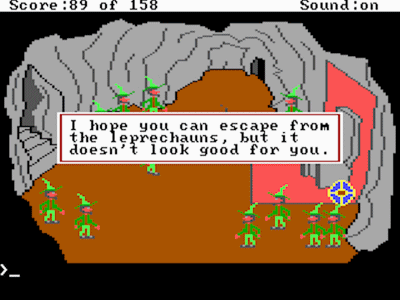
“Possibly the only time I recall running into a legion of evil Leprechauns in a game.”
I greatly prefer the revised backstory, as sheds so much more light onto the Kingdom and gives Sir Graham real purpose in completing his quest. Sure, you still casually stroll in an out of dangerous situations and never get too far beyond the confines of the castle itself, but it takes a lot less headcanon to get immersed in, at least. If you’re planning on playing any version of King’s Quest, I’d recommend reading it first.
All that explained, King’s Quest has nothing in the way of an actual in-game narrative and, until the very end, has no real plot development to speak of. Unlike other some games that set up a scenario and plop you down in it, the previously reviewed Maniac Mansion being a great example, the environment you explore, objects you find, and characters you meet do little to help flesh out the Kingdom of Daventry or add to the story. Sure, there’s a lot of neat things to discover along the way, but they largely feel like exactly what I imagine they are: a collection of random references to other stories. With such terse text descriptions and narrations and no conversation system, the game relies almost entirely on its graphics alone to give the world something akin to flavor. Unfortunately that’s not anywhere as close to as effective as some well written text could be. The SCI remake goes a ways into correcting this by having both more detailed graphics and animation and more verbose text, but even so, don’t expect to go into King’s Quest expecting to fall in love with the Kingdom of Daventry or be whisked away by the game’s intriguing plot.
Controls
I realize that describing the controls in such detail might be unnecessary, but since King’s Quest more or less invented this style of game, I feel like it’s appropriate to go into a bit more detail here.
Your screen is dominated by a third person perspective view of an area with your character positioned on it. You can move your character around on this screen from left to right and, typically, back in forth with some degree of depth, depending on the scene itself. Scenery and other obstacles can block your path, narrow paths and stair cases have to be navigated, etc. When the character leaves the screen they are moved on to the next scene. All of this movement is done in real time akin to a more action orientated game. Again, this was pretty groundbreaking stuff.
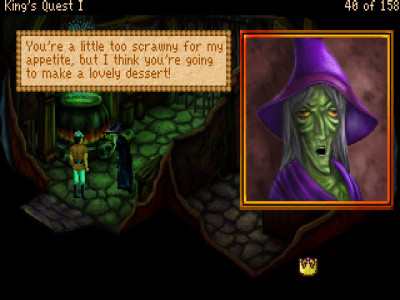
“A great example of the AGDI remake’s updated visuals.”
One common annoyance with this system is the fact that moment with the keyboard feels a bit imprecise, with pressing a direction starting movement and it not stopping until you manually attempt to stop it or you hit something. This can sometimes lead to falling off ledges or accidentally going too far and onto into another scene. It wouldn’t be so bad if you didn’t need to move so often, such as positioning Graham next to certain objects in order to interact with them, as opposed to being automatically moved as in later games. From my understanding, movement was actually intended to be done with a joystick, with the stick only moving Sir Graham when it is pressed one direction or another, stopping him when it is re-centered. While this works much, much better, I suspect the percentage of people who played this way was minuscule.
Couple that with the sometimes pixel perfect accuracy needed for navigating obstacles and you have probably the game’s biggest annoyance. At the very beginning of the AGI version of the game the player needs to take Graham across a bridge going over a moat and into the King’s castle. Many players fail to line Graham up on the 3D plane correctly or fail to adjust their path for the odd shape of the bridge, sending him into the moat where he’s quickly devoured by alligators. Having your character brutally die at the very start of the game while attempting to do something utterly inconsequential is a seriously fucking rude introduction to a game, I’ve got to say. Luckily this type of thing doesn’t happen too many more times, with the only other extremely notable occurrence being the giant beanstalk climb. This scene is infamous for how goddamn frustrating it can be, with even the slightest moment of even a fraction of Sir Graham’s hands leaving the beanstalk resulting in an instant, terrible death.
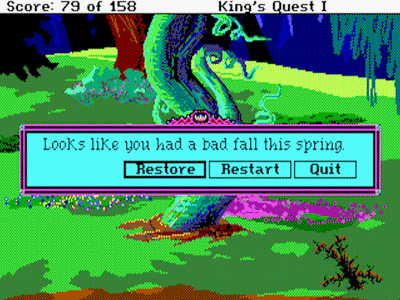
“Oh man, get used to seeing this goddamn screen.”
The SCI remake of the game added mouse movement of the sort that would later become standardized as the engine (and the entire genre) soon became totally “point and click” which, while having problems of its own, feels quite a bit better than using the keyboard to navigate in my opinion. Unfortunately, it’s still imprecise enough to cause scenes like the above mentioned beanstalk climb to suck just as much as in the original, that, and I swear they actually made the other way to and from Land of the Clouds more difficult. It feels like artificial difficultly rather than any sort of engine issue, which makes it all the more frustrating.
As mentioned, all control outside of movement is done via commands in a text parser, just as with text based adventure or interactive fiction games. The text parser is simple, not understanding a lot of phrasing or a lot of synonyms, but in a way its simplicity makes it easy to use, and I don’t think I ran into too many issues with getting it to do what I wanted. It’s not great, but it’s something that isn’t too difficult to work through. The biggest problem with it is that when something doesn’t work it is usually extremely vague and unhelpful about why.
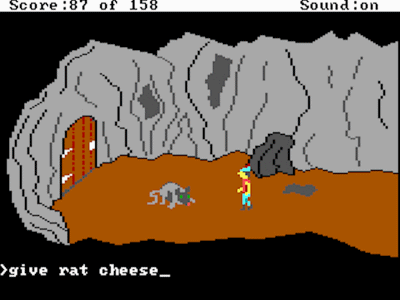
“Not the hardest puzzle in the game.”
Another complaint I have about the text parser is the lake of a consistent “look” or “look around” type command, which means a lot of opportunity to give us a flavorful written description of an area, including the notable objects in it, is wasted. From a practical standpoint, this means that if you can’t identify a part of the environment or an object you may not know how to look at it or pick it up. For instance, I had no idea that I was looking at a four leaf clover in the clover patch, or that it was even a clover patch to begin with, because “look ground” hadn’t worked on other screens earlier on so I had abandoned trying it, assuming instead that those funky shapes were just a different sort of flower like the ones on almost all of the screens depicting the wilderness around Daventry. Thankfully the SCI remake corrects this, adding a general “look” command and appropriate, nicely written descriptions of areas. It also maps looking at an object to the right mouse button, making it far easier to discover significant objects in the world, or at least milk every tidbit of flavor text out of a particular scene.
Finally, another important aspect of this kind of a text based input is time sensitive action. That is to say that when the action picks up, quickly trying to type in a command in such a way that the parser is happy with it, without typos, can be a bit of a pain. This is especially annoying when combined with the above mentioned movement issues. Getting close enough to an NPC to talk to it before it wanders away being the most common example. I didn’t have any major issue with this in King’s Quest, but the fact that the SCI remake pauses the action while you type in a command is a noticeable and much appreciated improvement.
The Tierra (now called “AGD Interactive”) remakes attempted to copy the more modern “point and click” interface of later SCI games, particular the implementation featured in King’s Quest V. I won’t go into depth about all of the differences in this review, but it does of course introduce some major changes, including a much more limited set of verbs to use. I personally have always preferred the point and click style interface, so I welcome the change, though it does feel a little disingenuous after just playing the original text input versions.
Graphics
The graphics of the original version of King’s Quest, as with other AGI games, are quite crude, with massive pixels resulting in an overall very blocky aesthetic. I’d always wondered why, despite the AGI and the SCI versions both outputting in 320 x 200, SCI games always looked so much better. Well, after some research I learned that this owes mostly to the game’s origins as a PCjr game. The AGI version actually renders at a lower resolution (160 x 200) and the pixels are doubled to 320 x 200 in order to save memory while still outputting what was at the time, a vibrant 16 color palette. I’d imagine this also made porting to the game to a variety of other contemporary platforms easier, since screens wouldn’t usually need to be reworked to accommodate for lower resolutions.
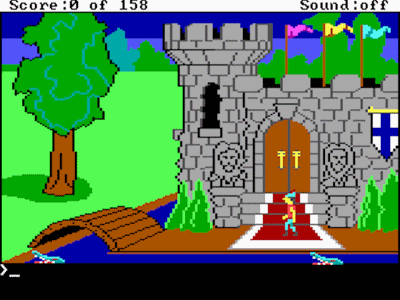
“Leaving Castle Daventry (AGI)”
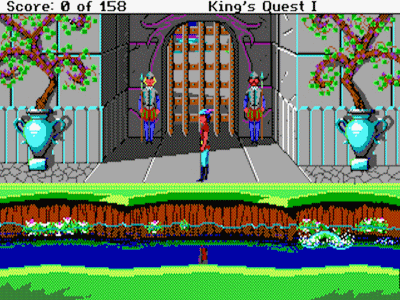
“Leaving Castle Daventry (SCI)”
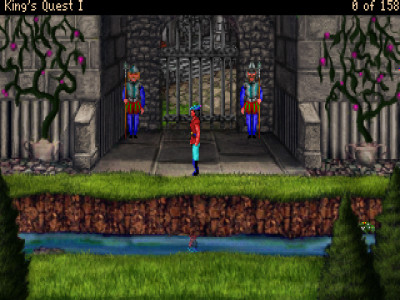
“Leaving Castle Daventry (VGA)”
The 1990 SCI remake of the game makes much better use of the resolution, with sharper, more detailed backgrounds and sprites, and uses the, by then limited, color palette much more effectively by deploying dithering techniques for more advanced shading effects, simulating more than 16 colors on the screen at once. While these early SCI Sierra games lack the beautiful, hand painted screens of later 256 color VGA games, they definitely didn’t lack the artistry that came with them. My main takeaway, having played both versions back to back, is that the improved graphics of the SCI remake give a lot more character to the world of King’s Quest, and given my above complaints about a lack of descriptive flavor helping define the game world in the Story section, is a welcome improvement. The more detailed animations don’t hurt either, even if they do to shift the game into a bit more of a exaggerated, cartoony direction.
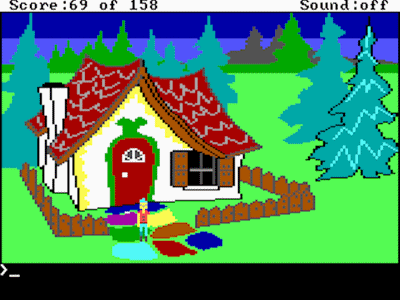
“The Gingerbread house looks… okay? (AGI)”
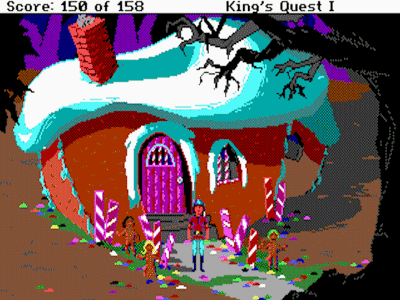
“Now that’s a little better! (SCI)”
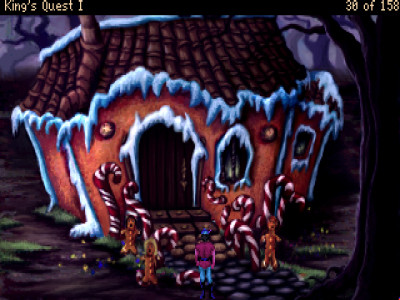
“Masterfully updated. (VGA)”
The more recent AGD Interactive remakes replace all of the art of the SCI version with new artwork. While the original releases included modified versions of many backgrounds and sprites taken from other Sierra VGA games, the current 4.x versions feature all new, hand painted art work. Interestingly, while the AGD Interactive remakes are often referred to as KQ1VGA, the graphics actually make heavy use of a full SVGA color palette. I actually prefer the look of the 256 color limitation of VGA when working with such a low resolution, as I find having so many colors on screen with so few pixels looks a little too “busy” but you can force the AGS engine down to run in lower color if it bothers you too much. Other than that, the AGD Interactive version of King’s Quest is quite nice, even if I personally prefer the art style of the SCI version overall.
Sound
The AGI version of King’s Quest unfortunately suffers from the poor sound support that all IBM PCs tended to have in the 80s, with only a sparse selection of harsh, PC speaker generated jingles and effects. The music was a little better on some other ports, like the Apple II version, but all of them are as equally sparse. Oddly, the original PCjr version actually had quite a few more sounds, even ambient effects such as birds chirping in the Daventry wilderness. From what I’ve heard these were pretty terrible though, and would probably quickly grow to annoy me to the point of turning the sound off, so maybe I should be content.
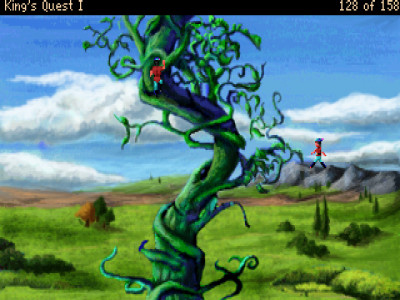
“The infamous (and breathtaking) beanstalk.”
The SCI remake features music and sound effects using Adlib or Roland MT32 sound. During most of the screens when you’re wandering around Daventry you have no music, only ambient sound effects like the ones I described on the PCjr, only they don’t suck this time around, and actually help with set the tone of exploring alone in a deep wilderness quite effectively. Music does queue up whenever anything interesting happens, like when you enter a special area or a particular event kicks off. There are a number of different songs, nearly one per each of these scenes, which, when combined with the addition of sound effects, add quite a lot to the presentation. I don’t think this King’s Quest soundtrack is necessarily one of the best ones Sierra ever put together or anything, but it does feel appropriate to the tone of the game, matching well with the remake’s bright colors and the game’s overall fairly tale fantasy vibe.
The AGD Interactive remake features more or less identical sound and music to the SCI version, with the music simply being a digital recording of the MT-32 soundtrack. The biggest difference here is that it includes a “speech pack” to add voices to practically all of the text in the game. This is a bit of a mixed bag in my opinion: I think giving a voice to narrator only adds to often enjoyably sarcastic text in the game, which is pure vintage Sierra by the way, and is mostly well executed. Many of the other voices are good, or at least passable as well. The worst offender is probably Sir Graham himself, which is a pity considering he’s voiced by Josh Mandel, who originally voiced Graham in the CD-ROM versions of King’s Quest V and King’s Quest VI. That said, Sir Graham barely talks in the first King’s Quest, so…
Old Age
I played both versions of the game on my dedicated gaming 486, often without worrying about disabling my internal cache or slowing down my machine further via any other method. I didn’t encounter any timing related problems apart from use of the engine’s “speed” setting – with speed on “fast” the game seems to run as fast as it can on your hardware, so while with my cache disable it can be useful for speeding up the process of backtracking, without slowing down my machine the feature is a recipe for an accidental death since I lose practically all sense of control. Not only that, but the speed setting effects everything, not just Graham’s walking animations, meaning all of the animations look hilariously fast too. The bigger issue you’ll need to work around to play King’s Quest on a proper DOS machine these days is disk copy protection. Thankfully most newer releases of the game, including those in most of Sierra’s collections, new and old, have been pre-cracked.
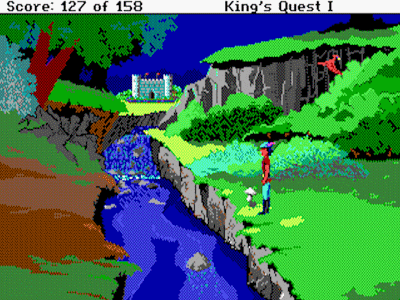
“Castle Daventry off in the distance.”
Playing it on a modern system is straightforward. DOSBox is, of course, an option for both versions. I only tested it with the AGI release, but it ran totally fine that way. As an added bonus you can also set your DOSBox to emulate Tandy sound which gives the PC speaker music sound a bit better. ScummVM is also an option, though currently it tends to work a lot better with SCI games than the older AGI ones. Some people have also made their own AGI interpreters updated to work on modern systems, probably the most notable of which is NAGI. You can, of course, emulate other ports and versions of King’s Quest on your platform emulator of choice too.
Thankfully, King’s Quest is easy to legally acquire these days. First of all, GOG has all of the King’s Quest games available in bundle (preconfigured to run with DOSBox) for relatively cheap. My only complaint is that the King’s Quest 1, 2, and 3 bundled doesn’t include the SCI remake, for some odd reason. The King’s Quest collection bundle available on Steam does, however. You can also track down the original disks on eBay, of course, but from what I’ve seen the original game seems to go for quite a lot of money. The various official King’s Quest collections Sierra put out are surprisingly much more reasonably priced, however.
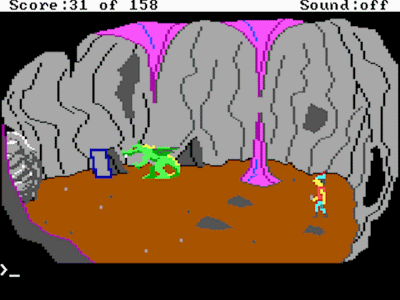
“A err… fearsome… Dragon? (AGI)”
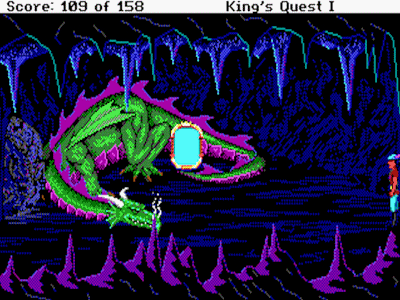
“There we go! (SCI)”
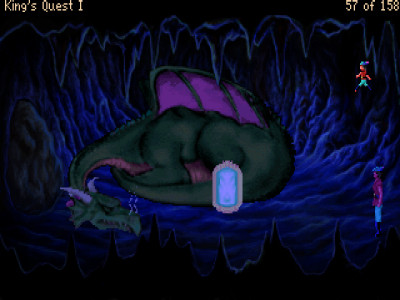
“I’m not sure which I prefer, really. (VGA)”
As mentioned, there is also the AGD Interactive re-make, which is freely downloadable. This re-make uses the excellent Adventure Game Studio engine to recreate the SCI version of King’s Quest while emulating the interface of King’s Quest V and providing updated, high color graphics and full speech as an added bonus. While there are some minor changes here and there, by and large this is a faithful recreation. AGS can be a bit temperamental when it comes to different graphical settings in particular, but with some experimenting you should be able to make this version work perfectly on a newer Windows machine. Personally, I ended up having to replace the main executable with one from the latest version of AGS to get the game to display with the correct stretched out, DOS style aspect ratio on my 5:4 monitor under Windows 10, and I never could get those settings to play well with the option to reduce the color palette, but your mileage may vary.
King’s Quest was ported all over the place to practically every popular personal computer out there at the time. Graphical output issues aside, these versions were more or less identical to the PC counterparts I reviewed here. The biggest differences were probably on the sound front, with so many older personal computers having wildly different sound chips. Other than some different music arrangements and quality of output, none of them were exceptionally different, however.
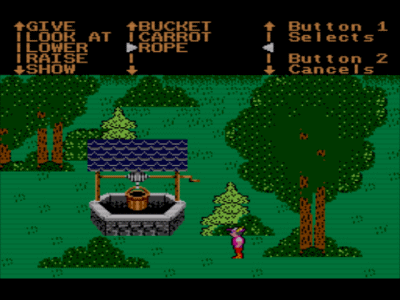
“King’s Quest on an 8 bit console. What an oddity.”
Believe it or not, there was actually also a port of King’s Quest to the Sega Master System, which is by far the most unique version. The puzzles and scenes are more or less the same as in the original AGI version of the game, but as you might expect, going to a system with even more constrained hardware specs the graphics and sound are entirely different. The control scheme in particular is pretty funky, using the controller’s digital pad to move, but using a verb and noun assembly menu, not totally unlike that in the original LucasArts SCUMM games, for performing other actions. It sounds nice, and with some minor tweaks it might be, but as-is it gets a little clunky when you have more than a few items in your inventory. For an 8 bit console port, however, it’s actually not terrible.
King’s Quest’s documentation is available in PDF format with any legit version of the game. Reading it isn’t at all required but, as mentioned before, I’d highly recommend you read the expanded backstory to give your quest in Daventry a little more flavor. Due to the King’s Quest series’ status as an absolute classic the manuals, original hint books, along with walkthroughs and other fan compiled information is also readily available at various sites online without too much searching. The Sierra Gamers community and Sierra Help are great places to start.
Sequels and Related Games
Sierra released two more AGI sequels, King’s Quest II: Romancing the Throne and King’s Quest III: To Heir Is Human before moving to SCI and releasing 4 more titles in the 1990s, cementing King’s Quest as perhaps their biggest franchise. The original series finally game to an end with the controversial 3D action/adventure title King’s Quest: Mask of Eternity. I’m sure I’ll end up reviewing some, if not all of these games in the future. Sadly, it wasn’t until The Odd Gentlemen released their episodic King’s Quest reboot in 2015 that we finally saw another official game in the series. I’ve talked a bit about the 2015 game in the past, if you’re interested.
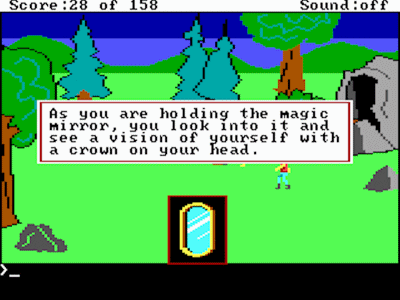
“Did I mention it tells the future? Let the sequels begin!”
While Sierra’s other “quest” games are often grouped together, it’s probably more fair to say that every single game based on the AGI engine, of which there were many, is related to King’s Quest. By extension, SCI engine games were as well. It suffices to say that if you like King’s Quest, either version, you’ll probably like at least some of Sierra’s other graphical adventure game offerings.
Closing
Given that it seems like I’m so often touting the historical relevance of a game when I’m concluding one of these retro reviews, I suppose I need to immediately give King’s Quest a recommendation on that merit alone. Without this game one of the my most beloved computer gaming genres, the graphical adventure game, might have never come to be. Sure, some of the later King’s Quest games go much further into giving you exciting narratives with opportunities to fall in love with the Kingdom of Daventry and it’s heroes and villains, but overall, despite the deaths and dead ends, I actually think the simplicity of King’s Quest could make it a great introductory adventure game for new players to sink their teeth into. Personally, I’m most fond of the 1990 SCI remake’s blend of artistic and technical presentation and it’s hybrid keyboard and mouse controls, but any version you can get your hands on, including the AGD Interactive remake, is a worthy diversion.
